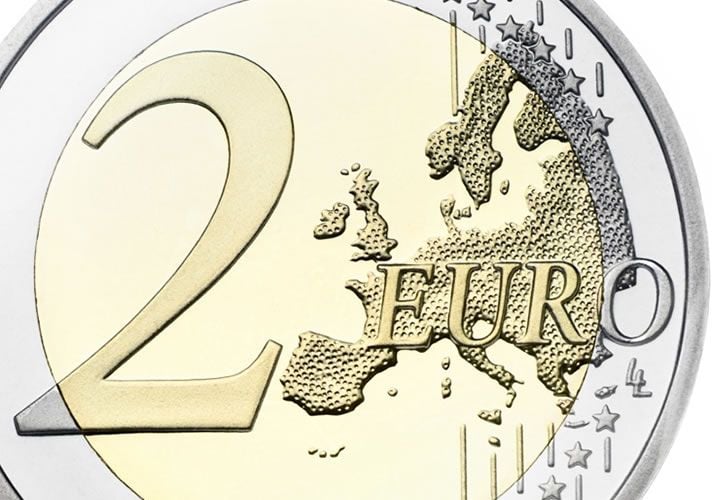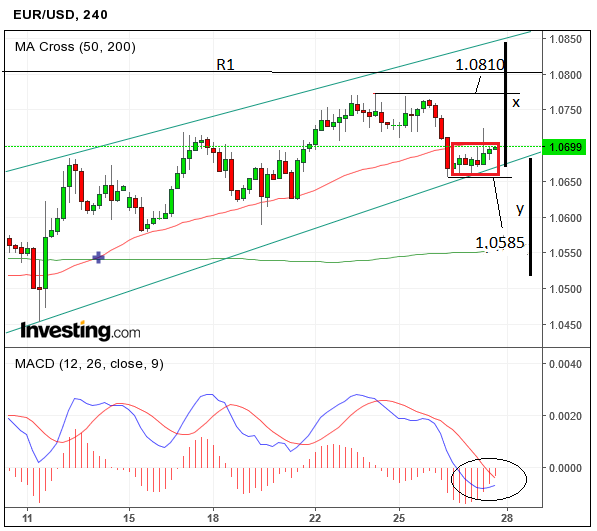Euro-Dollar Exchange Rate 5-day Outlook Mixed

A flat start to the new week for the Euro to Dollar exchange rate which is quoted at 1.0697; around about where it closed the previous week.
EUR/USD has been rising steadily for six straight weeks but it is showing signs of vulnerability.
We have witnessed the pair move from 1.0352 in mid-December to record a high of 1.0775 in the week ending January 27.
The pair is consolidating at the base of its rising channel, threatening to breakout below the lower borderline.
If it pushes below the 1.0657 lows, that would confirm a downside breakout with an initial target at support from the 50-day MA at 1.0585.
The target is calculated based on the height of the channel which is extrapolated down from the break to calculate the minimum expectation. Although below the 50-day MAV the exchnage rate may struggle to push below the moving average which often provides areas of support and resistance to price.
Alternatively, if the channel remains intact there is still a good chance the short-term uptrend will extend, and a break above the 1.0774 highs would confirm an extension to resistance at 1.0810.
A further break above the 1.0850 level, however, would confirm a probable extension higher to the major psychological level at 1.1000.
Analysts appear to be united in a bearish outlook for the pair.
“Technically, after struggling to break 1.08, the recent stretch of lower highs and lower lows in the EUR/USD indicates that we have seen a near-term top in the currency pair. With the dollar expected to trade higher on FOMC, we expect EUR/USD to pull-back to 1.06 and possibly even 1.0550 in the near term,” says Kathy Lien, Director of BK Asset Management.
ING’s FX Strategist Viraj Patel also sees the Federal Reserve’s February meeting as leading to a stronger Dollar, due to officials hinting at a March interest rate hike:
“EUR/USD should return below 1.0600. First, the FOMC meeting (Wednesday) where potential modest changes to the inflation outlook may prompt markets to price in a March rate hike. Second, the US Jobs report on Friday should show solid Jan average hourly earnings (2.6% year-on-year) and above consensus NFP (180k) – enough to keep the Fed’s hawkish tone intact.
“While EZ inflation should rise due to base effects (1.4%) this is unlikely to benefit the Euro via a change in outlook for ECB policy."
However, not everyone is negative on the shared-currency's prospects.
"Despite all the doom and gloom about the euro, the currency is holding up relatively well against the US Dollar. Its stay beneath 1.05 was short-lived. It has managed to turn positive for the month and thus year after climbing back above its 2017 opening price of around 1.0518 in the first week of the year," says Fawad Razaqzada at Forex.com.
As long as the EUR/USD remains above this level, the short-term bias remains bullish notes Razaqzada.
Data to Watch for the Single Currency
The main release for the Euro will be CPI on Tuesday at 10.00 GMT.
Headline inflation is expected to jump to 1.4% as already mentioned above, on rising fuel prices but Core Inflation will be the one to watch as it is likely to remain unchanged at 0.9% - but a move higher would impact the Euro.
A surprise increase in Core along with rising headline would push the single currency higher.
Other data includes the Unemployment Rate at, out at 10.00 GMT, which is expected to remain unchanged at 9.7%, and Q4 GDP released at the same time, which is forecast to show 1.7% growth year-on-year and 0.5% month-on-month.
More of the same steady growth is forecast.
The Pound Under Spotlight On Thursday
It is the Pound which is expected to supply the fireworks this week, with Thursday highlighted due to the BOE meeting and the release of the Quarterly Inflation Report.
There is potential for the Pound to strengthen as recent above forecast growth means the BOE will probably revise up their forecasts, according to Capital Economics’ Scott Bowman.
The strong consumption and stubbornly low unemployment means the BOE has more room to tackle rising inflation caused by the weak pound.
This, in turn, could lead to heightened expectations of a BOE rate hike and a change of stance from neutral to more hawkish, which would propel Sterling higher.
“We like buying pounds into the Quarterly Inflation Report, especially as it dips toward 1.25 with a target of 1.27/1.28,” says BK Asset Management’s Kathy Lien.
Other analysts, however, see Sterling pushed lower by the increasing reality of a “Hard” Brexit regardless of Parliament’s involvement.
“It's strange to see GBP performing so well when the path towards a 'hard' Brexit remains firmly on the table; strategically, we remain bearish on GBP/USD and look for fresh catalysts (namely dollar strength) to see a short-term move back towards the 1.24 level,” said ING’s Patel.
UK PMI data, out on Wednesday, Thursday, and Friday, also deserves a mention.
Manufacturing, Construction and Services PMI’s are released respectively at 9.30, with Manufacturing expected to pull-back a basis point to 56.0, Construction forecast to 53.8 from 54.2 and Services to 55.8 from 56.2.






